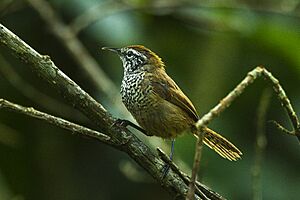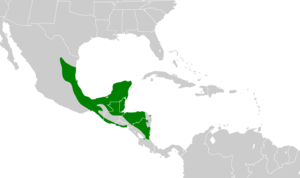Spot-breasted wren facts for kids
Quick facts for kids Spot-breasted wren |
|
|---|---|
 |
|
| In Chiapas, Mexico | |
| Conservation status | |
| Scientific classification | |
| Genus: |
Pheugopedius
|
| Species: |
maculipectus
|
 |
|
| Synonyms | |
|
|
The spot-breasted wren (Pheugopedius maculipectus) is a small, lively bird that belongs to the wren family, Troglodytidae. You can find this bird in several countries in Central America and Mexico, including Belize, Costa Rica, El Salvador, Guatemala, Honduras, Mexico, and Nicaragua.
Contents
About the Spot-Breasted Wren
The spot-breasted wren is a small bird, usually about 12.5 to 14 centimeters (5 to 5.5 inches) long. Males weigh a bit more than females.
What Does It Look Like?
Adult spot-breasted wrens have a reddish-brown head and back, with their lower back being a bit more chestnut-colored. Their tail is dull brown with thin dark stripes. They have a white stripe above their eye, and their face and neck are streaked with black and white.
Their chest and the middle of their belly are light gray with black spots, which is how they get their name! The sides of their body and lower belly are orange-buff and do not have spots. Young wrens are lighter in color, and their face markings and spots are not as clear.
There are a few different types, or subspecies, of the spot-breasted wren, and they can look slightly different:
- One type is less reddish and has fewer, smaller spots on its chest.
- Another type is paler and has a light, cinnamon-colored head.
- Some types are larger and darker than the others.
Where Do Spot-Breasted Wrens Live?
Spot-breasted wrens live in many different places, from humid forests near the coast to drier forests. They can be found in both untouched forests and areas where the forest has been disturbed or is growing back. They also like to live in cocoa and citrus farms.
You can find them from sea level up to about 1,300 meters (4,265 feet) high in Mexico and Honduras. In Costa Rica, they usually live at lower elevations, up to about 200 meters (656 feet).
Where Each Subspecies Lives
Different types of spot-breasted wrens live in specific areas:
- One type lives in northeastern Mexico, from Nuevo León to Veracruz.
- Another type is found in eastern Mexico, from Veracruz to Oaxaca.
- The Yucatán Peninsula, northern Belize, and Guatemala's Petén Department are home to another type.
- A widespread type lives from southern Mexico through southern Belize, most of Guatemala, El Salvador, Honduras, and parts of Nicaragua and Costa Rica.
- Two other types are found in northern Honduras, Nicaragua, and Costa Rica, as well as parts of Mexico, Guatemala, and El Salvador.
How Spot-Breasted Wrens Behave
Feeding Habits
Spot-breasted wrens usually look for food low down in thick plants. They often do this in pairs or with their family. They mostly eat small creatures like insects, but their exact diet is still being studied.
Reproduction and Nests
We know some interesting things about how spot-breasted wrens raise their young. Their breeding season changes depending on where they live. They build a dome-shaped nest with an opening on the side. These nests are usually placed in the fork of a tree or in ferns, up to 6 meters (20 feet) above the ground.
A female wren usually lays three to four eggs. Both the male and female parents help feed the baby birds.
Their Song
The spot-breasted wren has a lovely song! It's described as "a cheerful series of clear whistling gurgles." Both male and female wrens sing this song. You can even listen to it online! [1]
Conservation Status
The IUCN has listed the spot-breasted wren as a species of "Least Concern." This means they are not currently in danger of disappearing. There are at least 500,000 of these birds. However, it's a bit hard to know if their numbers are growing or shrinking because we're not sure how changes to their habitat affect them.


